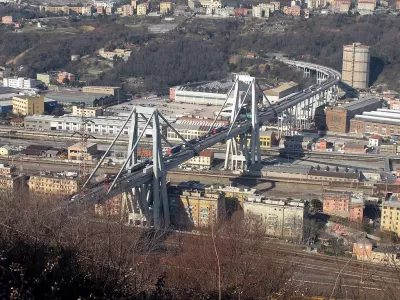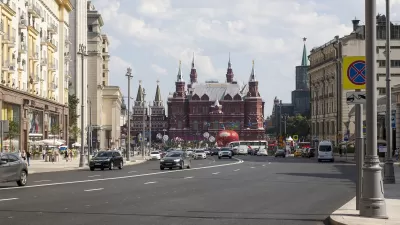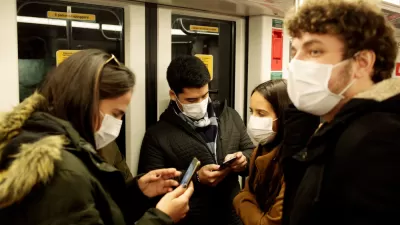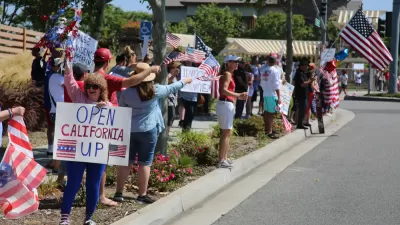At least 39 people died when the Ponte Morandi bridge collapsed in Genoa, Italy during a storm on Tuesday. The cable-stayed bridge is part of a viaduct on the A10 toll road that goes to France, operated and maintained by Autostrada per l'Italia.

"A vast span of the Morandi bridge caved in during a heavy rainstorm in the northern port city [of Genoa], sending about 35 cars and several trucks plunging 45 metres (150ft) on to railway tracks below," according to The Guardian.
"Italian political leaders have been quick to point the finger at [Autostrade per l’Italia,] the private company responsible for maintaining the Ponte Morandi Bridge," which opened in 1967 with the Autostrada A10, reports Amy Held for NPR. The cable-stayed bridge is named after designer Riccardo Morandi.
Deputy Prime Minister Matteo Salvini said he would work to "identify the culprits of this disaster, which will not go unpunished." He tweeted that those responsible will "pay dearly."
The company, a "leading European Concessionaire for toll motorway construction and management," according to owner Atlantia Group, defended its record of maintaining the 51-year-old bridge.
From 2012 to 2017, "the company's investments in safety, maintenance and upgrading of the network have exceeded 1 billion euros [$1.134 billion] a year," Autostrade said in a statement emailed to NPR. The company added that its safety investments have resulted in fewer deaths and accidents.
Officials say it's too early to explain why the bridge collapsed during the powerful storm. The New York Times account of the incident helps to put the government's response into context.
"The calamity presented a serious test of Italy’s new government, a coalition of populist parties that was formed only months ago, report Gaia Pianigiani, Elisabetta Povoledo and Richard Pérez-Peña on Aug. 14. "They rode to power on a wave of anti-establishment anger, but the coalition is led by people who had little to no experience governing, and now must demonstrate that they can manage a crisis and the scrutiny that comes with it."
"The Morandi bridge has been riddled with structural problems since its construction in 1967, which has led to expensive maintenance and repeated criticism from engineering experts," report The Guardian's Angela Giuffrida and Lorenzo Tondo.
On Tuesday the specialist engineering website Ingegneri.info published a piece that highlighted longstanding concerns over the bridge, calling it “a tragedy waiting to happen”.
"Restructuring work on the bridge was carried out in 2016," reported Giuffrida on Tuesday. "The highway operator said work to strengthen the road foundations of the bridge was being carried out at the time of the collapse, and the bridge was constantly monitored."
Sylvia Poggioli, senior European correspondent for NPR's international desk, also reports on the calamity (audio and transcript). In a separate, 5-minute (audio-only) interview on Wednesday with Here & Now's Robin Young, Poggioli explains that the bridge had exceeded its traffic capacity, the definition making it functionally obsolete but not necessarily structurally deficient.
"Italians pride themselves on repairing and restoring ancient things, and the idea of tearing something down....is not in their mentality," states Poggioli, adding, "this may require some revision."
John Surico also explores reasons for the bridge collapse in an insightful piece for CityLab. "The incident has sparked an urgent debate over the country’s ability to maintain its postwar infrastructure."
FULL STORY: Death Toll In Genoa Bridge Collapse Rises To 39

Alabama: Trump Terminates Settlements for Black Communities Harmed By Raw Sewage
Trump deemed the landmark civil rights agreement “illegal DEI and environmental justice policy.”

Planetizen Federal Action Tracker
A weekly monitor of how Trump’s orders and actions are impacting planners and planning in America.

Why Should We Subsidize Public Transportation?
Many public transit agencies face financial stress due to rising costs, declining fare revenue, and declining subsidies. Transit advocates must provide a strong business case for increasing public transit funding.

Understanding Road Diets
An explainer from Momentum highlights the advantages of reducing vehicle lanes in favor of more bike, transit, and pedestrian infrastructure.

New California Law Regulates Warehouse Pollution
A new law tightens building and emissions regulations for large distribution warehouses to mitigate air pollution and traffic in surrounding communities.

Phoenix Announces Opening Date for Light Rail Extension
The South Central extension will connect South Phoenix to downtown and other major hubs starting on June 7.
Urban Design for Planners 1: Software Tools
This six-course series explores essential urban design concepts using open source software and equips planners with the tools they need to participate fully in the urban design process.
Planning for Universal Design
Learn the tools for implementing Universal Design in planning regulations.
Caltrans
Smith Gee Studio
Institute for Housing and Urban Development Studies (IHS)
City of Grandview
Harvard GSD Executive Education
Toledo-Lucas County Plan Commissions
Salt Lake City
NYU Wagner Graduate School of Public Service





























